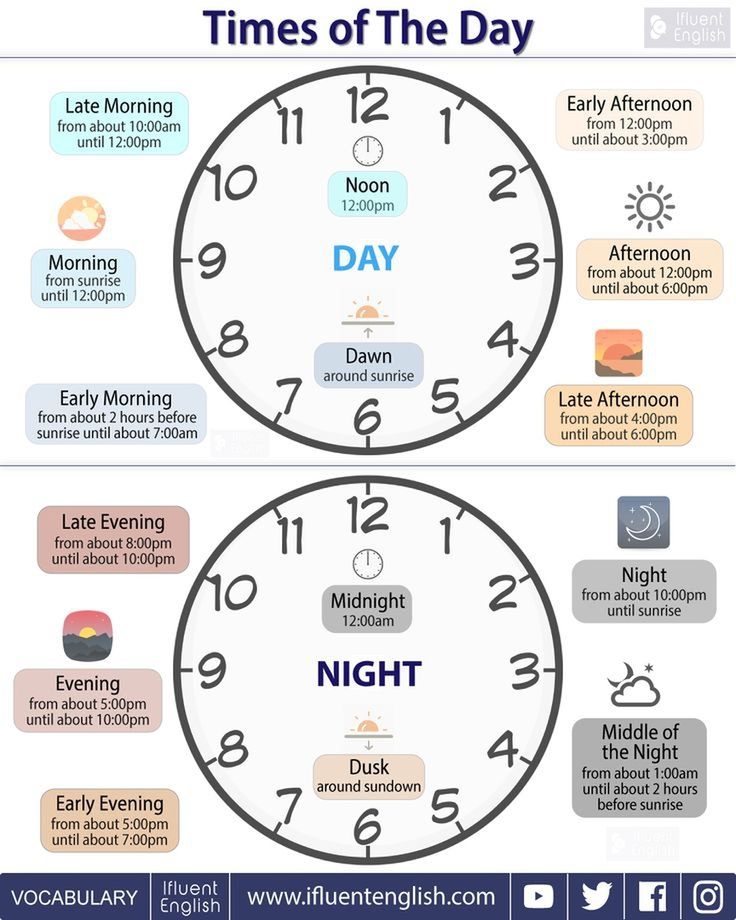Do i have selective mutism quiz
Do I Have Selective Mutism?
Can teenagers struggle with selective mutism? What about adults? The answer to both is yes. Have you ever asked yourself, “Why is it so hard for me to speak in front of people?” The question you should be asking yourself is, “Do I have selective mutism?” You should know that selective mutism usually starts in childhood but can affect people of any age. The first step to understanding selective mutism is to learn the signs and symptoms of this disorder. Selective mutism is more than just shyness. It is an anxiety disorder that affects a person’s ability to speak in public—often to debilitating effect.
Adults with selective mutism may have trouble interacting with others in group settings, social gatherings, and the workplace. They may also have chosen educational or career paths that have helped them avoid social interactions. Even for long-time undiagnosed cases of selective mutism, overcoming this anxiety disorder is possible with appropriate treatment.
How do you know if you have selective mutism? Start with this checklist. Do these selective mutism symptoms resonate with you? If so, it may be time to find a treatment professional who will help you find your voice.
You speak freely at home but shut down in public spaces
It can be confusing when you can speak openly and articulately around people with whom you feel comfortable but not when you’re in public. Selective mutism does not mean that you hate to talk. This anxiety disorder affects how you behave in public spaces, especially around people you don’t know well. Public spaces can include school, work, social gatherings, doctors’ offices, restaurants, and more—any place that brings you out of your normal routine and into contact with people you’re unfamiliar with may cause anxiety.
Your anxiety paralyzes you completely
Selective mutism can make it feel impossible to communicate in certain spaces, such as the classroom. Places where your anxiety has been triggered may become “contaminated,” making it even more difficult to speak up in similar situations in the future. If you’re experiencing anxiety from selective mutism, speaking may not feel like an option in the moment.
If you’re experiencing anxiety from selective mutism, speaking may not feel like an option in the moment.
You need time to adjust to social situations
Jumping into a social event can be hard, especially when you’re around people you don’t know well. When gatherings include strangers, acquaintances, extended family, classmates, or coworkers you are not close to, these situations can trigger anxiety. You may feel uncomfortable and struggle to make eye contact, answer questions, or speak in front of a group. Sometimes, this anxiety can be alleviated after a certain period of warm-up time to ease into socializing.
You resort to nonverbal communication to answer questions
When speaking feels overwhelming, it’s easy to resort to pointing, nodding, or writing down responses instead of talking. Even when faced with a direct question, you may not be able to find your voice. Nonverbal communication, such as pointing to a meal you wish to order, can feel like a safe alternative.
You have other forms of anxiety
Often, other anxiety diagnoses co-occur with selective mutism. Do you have generalized anxiety disorder, panic disorder, social anxiety disorder, or a specific phobia? According to the National Institute of Mental Health, people diagnosed with selective mutism are often diagnosed with an additional anxiety disorder, most commonly social anxiety disorder. If you’re already working on treating an anxiety disorder, your treatment plan may go hand-in-hand with treatment for selective mutism.
In public spaces, you only feel comfortable speaking through a trusted individual
Maybe you have a friend order for you at a restaurant or have a family member ask for directions to the bathroom at a store. You find it much easier to communicate with someone you know well than to interact with a stranger, so much so that when it’s required to talk to someone you don’t know well, you might freeze up or avoid the situation entirely.
You avoid social situations due to anxiety
If left untreated, selective mutism may lead you to completely avoid social situations with people you don’t know well. The anxiety of leaving your comfort zone might feel like too much to overcome. This may look like: avoiding gatherings if unfamiliar people will be in attendance, not raising your hand in class when you know the answer, rejecting a promotion that would require speaking in front of a group at work, not scheduling medical appointments that would put you in a new situation with an unfamiliar doctor, avoiding activities you might otherwise enjoy if they didn’t have a social component, such as group sports, and more.
The anxiety of leaving your comfort zone might feel like too much to overcome. This may look like: avoiding gatherings if unfamiliar people will be in attendance, not raising your hand in class when you know the answer, rejecting a promotion that would require speaking in front of a group at work, not scheduling medical appointments that would put you in a new situation with an unfamiliar doctor, avoiding activities you might otherwise enjoy if they didn’t have a social component, such as group sports, and more.
Your symptoms persist over time and significantly impair your life
This is the most important diagnostic tool for selective mutism: If your symptoms persist over time and significantly impair your life, it may be time to seek treatment. Treating professionals can help you navigate your options for treatment, whether through medication or other methods to treat the underlying anxiety, therapy to help you take small steps to adapt to new social challenges, or other forms of treatment.
How many of these symptoms did you check off? If you or someone you know is wondering, “Do I have selective mutism?”, remember this checklist and know you can work through this anxiety. A treating professional can diagnose selective mutism and develop an individualized treatment plan. Find treating professionals who have joined the Selective Mutism Association, Our directory is organized by country and state to make finding help easy for you. Become a member of the Selective Mutism Association for even more resources.
Do I Have Anxiety? Self-Test
Contents
- Self-Test Here Using the GAD-7
- The Anxiety Epidemic
- Generalized Anxiety Disorder & the GAD-7
- Generalized Anxiety Disorder Symptoms
- What are the Types of Anxiety?
- Risk Factors & Prevention
- Treatments for Anxiety
Anxiety is usually a normal and sometimes even healthy emotion. Anxiety is one of the body’s ways of motivating itself to take direction and it can be triggered by physical or psychological stress.
However, when a person regularly feels disproportionate levels of anxiety, it might be a sign of generalized anxiety disorder[1]. Anxiety disorders form a category of mental health diagnoses that lead to excessive nervousness, fear, apprehension, and worry.
These disorders alter how a person processes emotions and behaves, which may cause physical symptoms. Mild anxiety might be vague and unsettling, while severe anxiety may seriously affect day-to-day living.
Unfortunately, as the world evolves around us, many new sources of stress affect the average human. According to large population-based surveys, up to 33.7% of the population are affected by an anxiety disorder during their lifetime[2].
Self-Test Here Using the GAD-7
This questionnaire, called the GAD-7 screening tool, can help you determine if you might have an anxiety disorder that needs treatment. This screening tool calculates how many of the common symptoms you have and suggests where you might be on a scale from mild to severe anxiety[4].
Please consult a mental health professional as soon as possible if your responses indicate you suffer from moderate to severe anxiety. If you received a score in the minimal to mild anxiety range, your risk for anxiety is low. However, you should seek professional help to obtain an accurate diagnosis.
The Anxiety Disorder Epidemic
The way that anxiety manifests itself has not really changed over the centuries. We’re still plagued by the same forms of anxiety disorder as our ancient ancestors, but the things that trigger our anxiety have certainly changed.
As the coronavirus pandemic continues to spread, an emotional pandemic is also following fast in its wake. More and more, doctors are reporting the spread of despair, worry, and depression among their patients. This is especially true for those already suffering from some form of anxiety disorder.
Even in our modern world, some of these traditional sources of anxiety are on the rise. These include loneliness, relationship factors such as divorce, violence and abuse including childhood abuse and neglect, increased working hours and more stressful work procedures, and a general sense of lack of control over our destinies.
Younger generations suffer from traditional sources of anxiety as they are introduced to the possibility of failure earlier and earlier in their lives due to increased systematic educational testing.
Generalized Anxiety Disorder & the GAD-7
Psychologists use various methods to diagnose a generalized anxiety disorder, including physical examinations and checking symptoms against the Diagnostic and Statistical Manual of Mental Disorders (DSM-5), published by the American Psychological Association.
One of the most common evaluations is the GAD-7 (Generalized Anxiety Disorder 7). This tool quantifies common symptoms and allows professionals to monitor their severity based on the DSM-5 criteria for generalized anxiety disorder[3].
The GAD-7 was created to help develop a brief self-report scale to identify probable cases of GAD. The GAD-7 only focuses on one anxiety disorder – Generalized Anxiety Disorder, the most common type of anxiety disorder. Although, it can still be helpful in identifying other types of anxiety. The GAD-7 can also be a helpful self-reporting tool that helps physicians establish a baseline for patient mental health[3].
Although, it can still be helpful in identifying other types of anxiety. The GAD-7 can also be a helpful self-reporting tool that helps physicians establish a baseline for patient mental health[3].
Generalized Anxiety Disorder Symptoms
Contrary to the social stigma associated with anxiety, anxiety is not just the feeling of fear or panic. It can have other significant effects on your body and mind.
Some symptoms that anybody with anxiety can experience are[5]:
- Feeling nervous, restless, or tense
- Having a sense of impending danger, panic, or doom
- Having an increased heart rate
- Breathing rapidly (hyperventilation)
- Sweating
- Trembling
- Feeling weak or tired
- Trouble concentrating or thinking about anything other than the present worry
- Having trouble sleeping
- Experiencing gastrointestinal (GI) problems
- Having difficulty controlling worry
- Having the urge to avoid things that trigger anxiety
Symptoms in Children and Teenagers
Children and teenagers may have similar worries to adults.
They may also have excessive concerns about:
- Performance at school or sporting events
- Family members' safety
- Being on time (punctuality)
- Earthquakes, nuclear war, or other catastrophic events
A child or teen with excessive worry may:
- Feel overly anxious to fit in
- Be a perfectionist
- Redo tasks because they are not perfect on the first try
- Spend excessive time doing homework
- Lack confidence
- Strive for approval
- Require a lot of reassurance about performance
- Have frequent stomachaches or other physical complaints
- Avoid going to school or avoid social situations
What are the Types of Anxiety?
If you’ve taken the GAD-7 test and discovered that you are at risk of having mild to severe anxiety, there are steps you can take to help with your anxiety. In tandem with reaching out to a mental health professional, it’s essential to learn that anxiety comes in various forms and may stem from multiple sources or afflictions.
In tandem with reaching out to a mental health professional, it’s essential to learn that anxiety comes in various forms and may stem from multiple sources or afflictions.
Sometimes, anxiety may not even have an obvious cause and can linger for a long time for no apparent reason.
Types of anxiety include:
Agoraphobia
This is a type of anxiety disorder where you fear and often avoid places or situations that might cause you to panic. This panic can manifest in making you feel trapped, helpless, or embarrassed.
Anxiety Disorder Due to a Medical Condition
This disorder includes intense anxiety or panic symptoms directly caused by a physical health problem.
Generalized Anxiety Disorder
This disorder includes persistent and excessive anxiety and worries about activities or events – even ordinary, routine issues. The concern is out of proportion to the actual circumstance, is difficult to control, and affects how you feel physically. It often occurs along with other anxiety disorders or depression.
It often occurs along with other anxiety disorders or depression.
Panic Disorder
Panic disorder involves repeated episodes of sudden feelings of intense anxiety and fear or terror that peaks within minutes (panic attacks). You may have feelings of impending doom, shortness of breath, chest pain, or a rapid, fluttering, or pounding heart (heart palpitations). These panic attacks may lead to worrying about them happening again or avoiding situations in which they’ve occurred.
Selective Mutism
Selective mutism manifest itself in children as a consistent failure for children to speak in certain situations. Children may struggle to speak in places like school, even though they can speak in other situations. This can interfere with school, work, and social functioning.
Separation Anxiety Disorder
This is often a childhood disorder characterized by anxiety that can be excessive for the child’s developmental level and is related to separation from parents or others who have parental roles. This disorder can be seen in adults as well.
This disorder can be seen in adults as well.
Social Anxiety Disorder
This disorder involves high levels of anxiety, fear, and avoidance of social situations due to feelings of embarrassment, self-consciousness, and concern about being judged or viewed negatively by others.
Specific Phobias
Social phobias are characterized by significant anxiety when you’re exposed to a specific object or situation and a desire to avoid it. Phobias provoke panic attacks in some people.
Substance-Induced Anxiety Disorder
Substance-induced anxiety disorder is characterized by symptoms of intense anxiety or panic that directly result from misusing drugs, taking medications, being exposed to a toxic substance, or withdrawing from drugs.
Risk Factors & Prevention
The following factors may increase the risk of developing generalized anxiety disorder:
- Personality – A person whose temperament is timid or negative or who avoids anything dangerous may be more prone to generalized anxiety disorder than others are.

- Genetics – Generalized anxiety disorder may run in families.
- Experiences – People with a generalized anxiety disorder may have a history of significant life changes, traumatic or damaging experiences during childhood, or a recent traumatic or negative event. Chronic medical illnesses or other mental health disorders may increase risk.
There’s no way to predict for certain what will cause someone to develop a generalized anxiety disorder. Still, you can take steps to reduce the impact of symptoms if you experience anxiety:
- Get help early – Anxiety, like many other mental health conditions, can be harder to treat if you wait.
- Keep a journal – Keeping track of your personal life can help you and your mental health professional identify what's causing you stress and what seems to help you feel better.

- Prioritize issues in your life – You can reduce anxiety by carefully managing your time and energy.
- Avoid unhealthy substance use – Alcohol and drug use and even nicotine or caffeine use can cause or worsen anxiety. If you're addicted to any of these substances, quitting can cause you more anxiety. If you can't quit on your own, see your doctor or find a treatment program or support group to help you.
Treatments for Anxiety
Anxiety disorders are generally treated with psychotherapy, medication, or both. There are many ways to treat anxiety, and people should work with their doctor to choose the treatment that is best for them[7].
Here are some treatments and therapies that your physician may recommend in your fight against anxiety:
- Psychotherapy
- Cognitive Behavioral Therapy (CBT)
- Anti-Anxiety Medications
- Antidepressants
- Beta-blockers
- Support Groups
- Stress Management Techniques
You Can Win the Fight Against Anxiety
After taking the GAD-7 self-test, you may have discovered you are at risk of having mild to severe anxiety.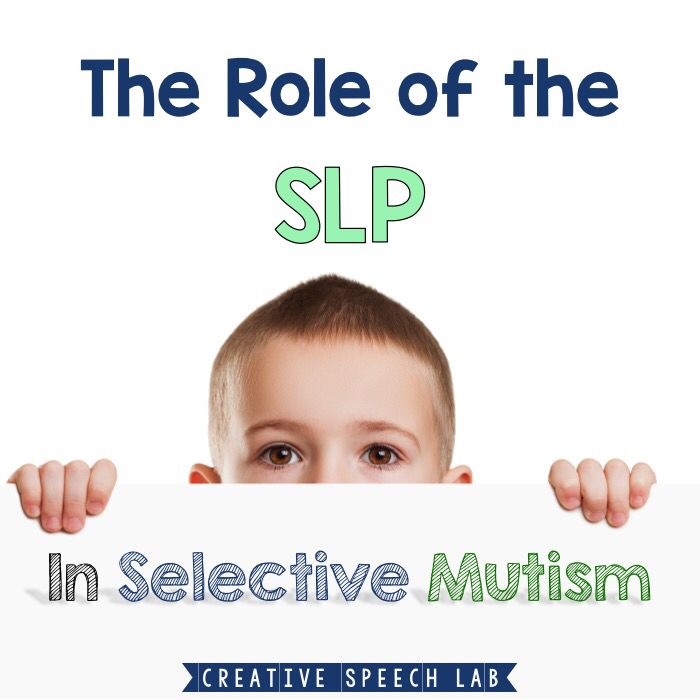 Although learning you may struggle with an anxiety disorder can be unsettling, SoCal Mental Health is here to help. We can help you understand anxiety and provide you with various treatment programs that will help you find recovery.
Although learning you may struggle with an anxiety disorder can be unsettling, SoCal Mental Health is here to help. We can help you understand anxiety and provide you with various treatment programs that will help you find recovery.
Please feel free to contact us if you or a loved one is struggling with anxiety. Our staff here are more than happy to assist you in finding recovery from anxiety.
Please feel free to contact us if you or someone you know and love needs help in their fight. Our staff here are more than happy to assist you.
Sources
- Mayo Clinic (2017, October 13) Generalized Anxiety Disorder.Retrieved January 14, 2022 from https://www.mayoclinic.org/diseases-conditions/generalized-anxiety-disorder/symptoms-causes/syc-20360803
- Bandelow, B MD, PHD (2015 September) Epidemiology of Anxiety Disorders in the 21st Century. Retrieved January 14, 2022 from https://www.ncbi.nlm.nih.gov/pmc/articles/PMC4610617/
- Spitzer, R. L (2006, May 22) A brief measure for assessing generalized anxiety disorder: the GAD-7.
 Retrieved January 14, 2022 from https://pubmed.ncbi.nlm.nih.gov/16717171/
Retrieved January 14, 2022 from https://pubmed.ncbi.nlm.nih.gov/16717171/ - University of Michigan (2021) Self-Test for Anxiety. Retrieved January 14, 2022 from https://www.uofmhealth.org/sites/default/files/healthwise/media/pdf/hw/form_abn2339.pdf
- Mayo Clinic (2018, May 4) Anxiety Disorders. Retrieved January 14, 2022 from https://www.mayoclinic.org/diseases-conditions/anxiety/symptoms-causes/syc-20350961
- McClean C. P, Asnaani A. (2011, March 25) Gender Differences in Anxiety Disorders: Prevalence, Course of Illness, Comorbidity and Burden of Illness. Retrieved January 14, 2022 from https://www.ncbi.nlm.nih.gov/pmc/articles/PMC3135672/
- National Institute of Mental Health. Anxiety Disorders. Retrieved January 14, 2022 from https://www.nimh.nih.gov/health/topics/anxiety-disorders
What is selective mutism and how to treat it - Knife
What is selective mutism and how to treat it - Knife Little is known about selective mutism. This is a selective refusal of speech in children who, as a rule, do not use speech skills outside the home, and especially in educational institutions. At the same time, sometimes such children can communicate with the help of mean gestures, monosyllabic answers to questions and whispers. In Russia, as in many other countries, there is neither a clear diagnostic system, nor special treatment methods, nor doctors dealing with this problem separately. We talked about it with mothers whose children have selective mutism, as well as with British therapist Lucy Nathanson, who specializes in this disease.
At the same time, sometimes such children can communicate with the help of mean gestures, monosyllabic answers to questions and whispers. In Russia, as in many other countries, there is neither a clear diagnostic system, nor special treatment methods, nor doctors dealing with this problem separately. We talked about it with mothers whose children have selective mutism, as well as with British therapist Lucy Nathanson, who specializes in this disease.
ShareRepostTweet
According to the Moscow Institute of Correctional Pedagogy, this disorder occurs in 1% of children, more often in girls.
“Selective mutism (SM) is a separate diagnosis, it is included in ICD-10 and ICD-11. As a rule, the appearance of SM is preceded by other disorders of speech development, - says the head of the Center for Behavioral Neurology of the Institute of the Human Brain named after N.P. Bekhtereva Leonid Chutko. - Anxiety, which is noted in 75% of children with SM, plays a large role in the genesis of the disease.
There is no specific therapy. In our country, nootropics and anti-anxiety drugs are usually used in conjunction with cognitive behavioral therapy, art therapy and family psychotherapy.”
According to experts, the most important thing is to create a comfortable psychological atmosphere for the child in which he would feel safe and be able to realize his potential: you need to find an activity for the child, motivate him and praise him for his achievements.
Natalya Tatarinova
mother of a daughter with selective mutism, founder of communities for parents of children with SM on VKontakte and Instagram*
Until my daughter was three years old, I did not notice any oddities in her. She developed like all children at her age and communicated with all family members. But a month after Adriana started going to kindergarten, a children's speech therapist called us and said that her daughter was talking to only one girl in the group.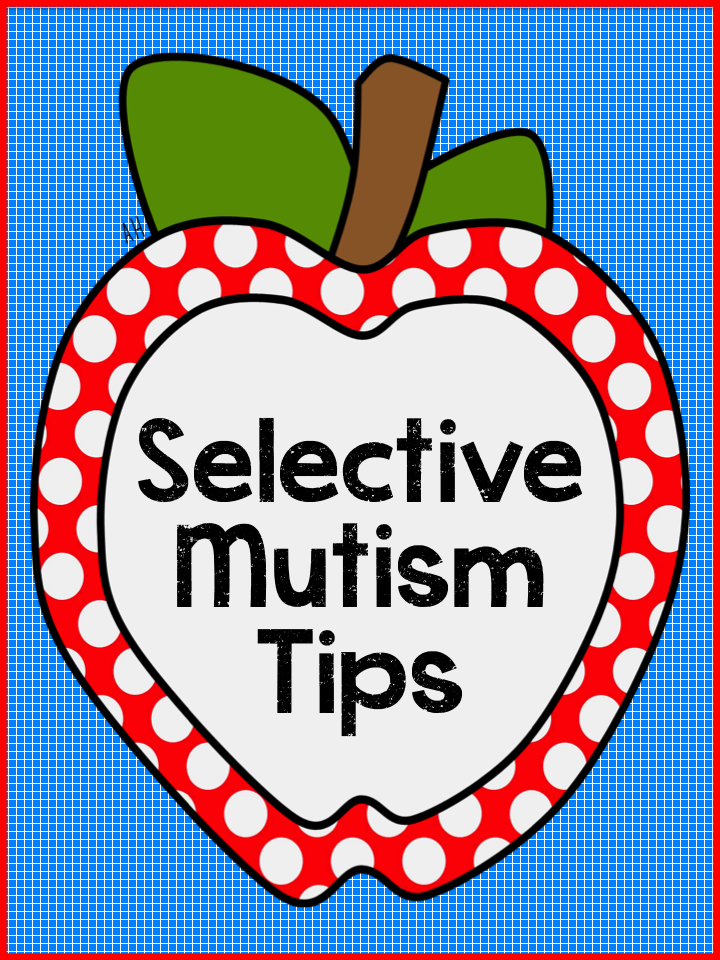 Then I did not take her advice to take my daughter to a neurologist seriously, deciding that Adriana was just embarrassed, that she would “outgrow it”.
Then I did not take her advice to take my daughter to a neurologist seriously, deciding that Adriana was just embarrassed, that she would “outgrow it”.
Soon we moved to St. Petersburg and transferred our daughter to a private kindergarten. But even in comfortable conditions in a small group of ten people, she never spoke to anyone. That's when I really got worried and started looking for a competent child psychologist.
Friends advised us to consult online with Maria Ignatova from Krasnodar. It was she who first made the assumption that her daughter had selective mutism and referred us to a psychiatrist. She also recommended involving Adrian in your affairs, taking her with you to visit or to dance classes - that is, to include her in society as much as possible. And also find a community of parents of mulatto children on the Internet (Adriana's father is from Africa. - Ed.) and arrange acquaintances for children. On her advice, I made friends with several parents in kindergarten, explained the situation to them and began to invite them to visit us with the children.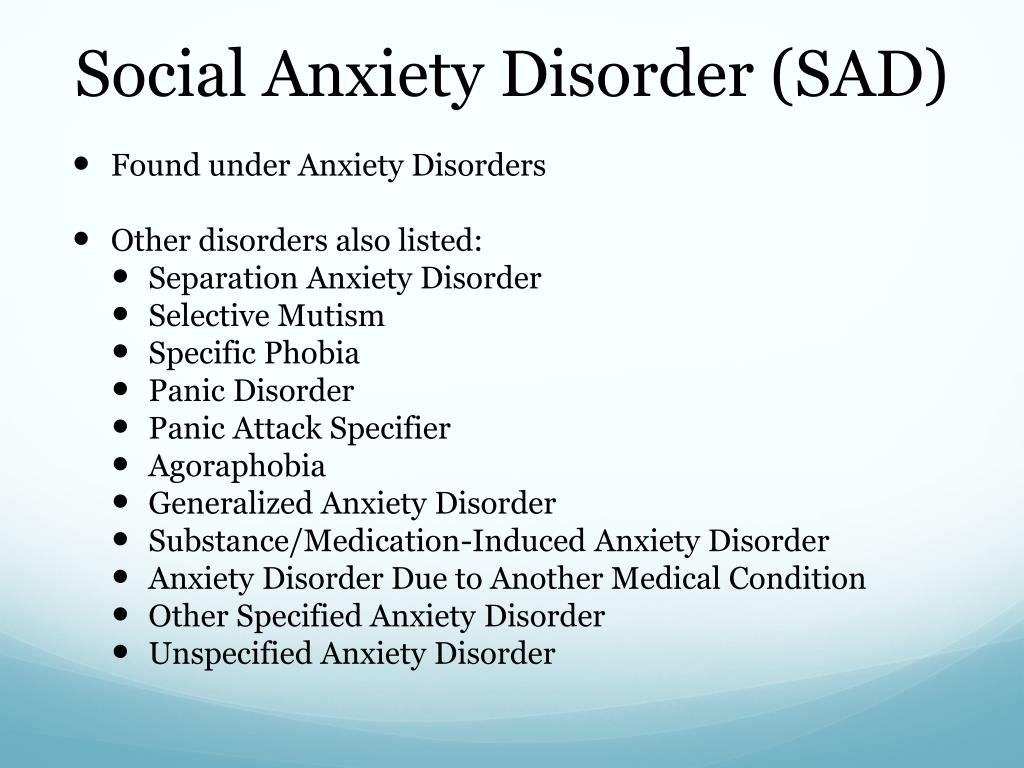 Later, I made information leaflets about selective mutism, and now, when I come with a child to a clinic or a children's club, I distribute printouts to everyone - I work ahead of the curve.
Later, I made information leaflets about selective mutism, and now, when I come with a child to a clinic or a children's club, I distribute printouts to everyone - I work ahead of the curve.
After a consultation with a psychiatrist, for the first time I thought that the problem could be hereditary and called Adriana's father. When we met, he seemed rather shy, but he had no obvious communication problems. When he learned about his daughter's diagnosis, he was not too surprised. “In childhood, I wasn’t just talking, I was afraid to eat in front of people,” he told me. The psychiatrist prescribed drug therapy combined with psychotherapy for her daughter. But the drug she prescribed is allowed in Russia only from the age of six. Therefore, for now, we do without it.
Recently, Adriana began to go to sand therapy, it discharges her emotionally very much: she tells me with pleasure what she did in the class, and at the same time she became somehow calmer. But in the team, she still practically does not communicate with anyone. We had to change kindergarten, and Adriana behaves even more closed there: her shoulders even tighten with excitement when she enters the classroom. We were sent to the pedagogical commission, and just imagine: a speech therapist, a child psychologist and a kindergarten head are sitting, and I tell them what selective mutism is. They have never heard of such a thing!
We had to change kindergarten, and Adriana behaves even more closed there: her shoulders even tighten with excitement when she enters the classroom. We were sent to the pedagogical commission, and just imagine: a speech therapist, a child psychologist and a kindergarten head are sitting, and I tell them what selective mutism is. They have never heard of such a thing!
Adriana never spoke to the speech therapist - she had to show the video with her daughter so that she could draw some conclusions. After that, the speech therapist said: “Your daughter does not have a pronunciation disorder, so I can neither give you a referral to a speech therapy garden, nor put a ZPR. We have such children, but they study according to the usual program. And homework is sent in video format.” Unfortunately, we have very little information about selective mutism, and it is mostly outdated, so I have to translate foreign articles myself.
Experts either think it will go away on its own or diagnose it as developmental delay.
 When I started running a group on VKontakte and met other parents of such children, I learned how selective mutism manifests itself in different ways.
When I started running a group on VKontakte and met other parents of such children, I learned how selective mutism manifests itself in different ways. Adriana, for example, talks to me at home and on the street, and when she enters an unfamiliar place, she immediately falls silent. Someone, on the contrary, communicates in kindergarten, and speech is turned off at home. Drugs help some children, and there is progress in a couple of months, while others do not start talking until they are eight years old. So everything is very individual here. Now I am planning a meeting with families where there are children with selective mutism. I would like to see how they interact with each other.
* Part of the Meta company, which is recognized as an extremist organization and banned on the territory of the Russian Federation.
Ksenia Medvedeva
mother of a son with selective mutism
I have two children. The eldest son Artem suffers from selective mutism. For a long time, we did not suspect this diagnosis - at home, the son communicated with us quite normally, clearly expressed his thoughts. Of course, he was always a reserved, anxious child, he had few friends in kindergarten. But we thought that we were growing an introvert, there were no particular concerns. When Artem was five years old, we transferred him to a correctional eye kindergarten, and then the situation worsened. Perhaps stress also affected - we had a daughter. Experts said that this is a common story - after the birth of the youngest child, the older child is given less attention, he feels abandoned, and begins to behave worse.
For a long time, we did not suspect this diagnosis - at home, the son communicated with us quite normally, clearly expressed his thoughts. Of course, he was always a reserved, anxious child, he had few friends in kindergarten. But we thought that we were growing an introvert, there were no particular concerns. When Artem was five years old, we transferred him to a correctional eye kindergarten, and then the situation worsened. Perhaps stress also affected - we had a daughter. Experts said that this is a common story - after the birth of the youngest child, the older child is given less attention, he feels abandoned, and begins to behave worse.
The teachers began to complain that Artyom did not play with other children, did not draw or do crafts with everyone else. When I asked if they were trying to involve the child in some kind of activity, they answered that they would not persuade Artyom, since he was already an adult. At home, the son said that everyone in the kindergarten was evil. It got to the point that he begged not to take him to the garden, fell asleep badly.
It got to the point that he begged not to take him to the garden, fell asleep badly.
When the pandemic started, I sat at home with my children for six months. And then it was time to enroll my youngest daughter in kindergarten, and I decided to take Artyom too. Moreover, child psychologists told me that he cannot be isolated, he needs to communicate with other children. And in the new kindergarten - the most ordinary one, with a group of twenty-five people - we were lucky to have a teacher. She tried her best to "rock". For example, I took him by the hand and made him draw with her. And he gradually got involved.
One winter, Artyom fell while walking and cut his cheek on the ice. Blood flows, but he is silent, does not make a sound, only tears flow down his cheeks. After this incident, the teacher advised us to go to a specialist in kindergarten No. 53. They work with autistic children and give free consultations. The neurologist did an encephalogram and said that there were no neurological problems. We went to the psychiatrist, he prescribed a light antidepressant sertraline. The result was not long in coming - my son's anxiety disappeared, he began to sleep better. In kindergarten, Artyom began to actively gesticulate - it became easier for teachers and children to understand him. A month later, he was already making some sounds. Then he spoke in a whisper, in the ear of the children he liked. The psychologist advised me to motivate my son to speak.
We went to the psychiatrist, he prescribed a light antidepressant sertraline. The result was not long in coming - my son's anxiety disappeared, he began to sleep better. In kindergarten, Artyom began to actively gesticulate - it became easier for teachers and children to understand him. A month later, he was already making some sounds. Then he spoke in a whisper, in the ear of the children he liked. The psychologist advised me to motivate my son to speak.
So we got a box of sweets, and we asked the teachers to “reward” Artyom for every word he said. In addition, we draw a social story for our son - this is something like a comic book in which your child is the main character, and you gradually draw different situations and how you need to behave in them.
I drew and explained to my son: “It’s you, here you come to the garden and greet the teacher”, etc. I also create social situations myself to involve my son in a conversation: we go to the store, I give him money and I ask you to buy something yourself.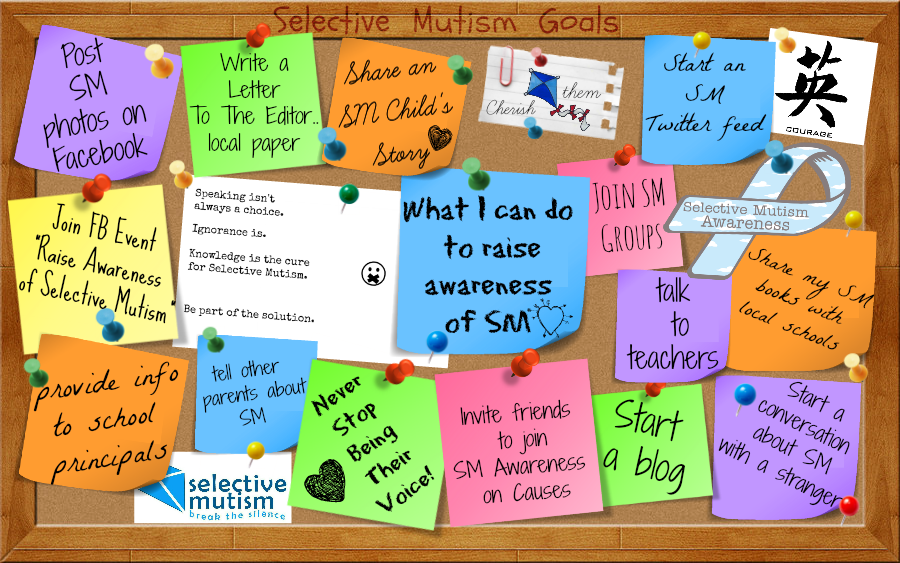 Progress is slow, but there is. Although, for now, Artyom flatly refuses to talk to caregivers and doctors.
Progress is slow, but there is. Although, for now, Artyom flatly refuses to talk to caregivers and doctors.
When I started looking for information about selective mutism, I came across posts on social networks written by teenagers with this problem. It turned out that even if the child was cured, the disease can "catch up" with him at an older age.
Lucy Nathanson
British therapist specializing in children with selective mutism, author of books on SM
I have been dealing with selective mutism for many years. Now I have a small team of specialists working with me. About twenty families from all over the world contact us every week. The geography is extensive: USA, Australia, China, Poland. We have already helped hundreds of such families. I suspect that there are many more children with selective mutism in Russia than the statistics show. Some time ago in the UK, things were similar - such children were at best considered very shy or silent, and sometimes they were diagnosed with autism.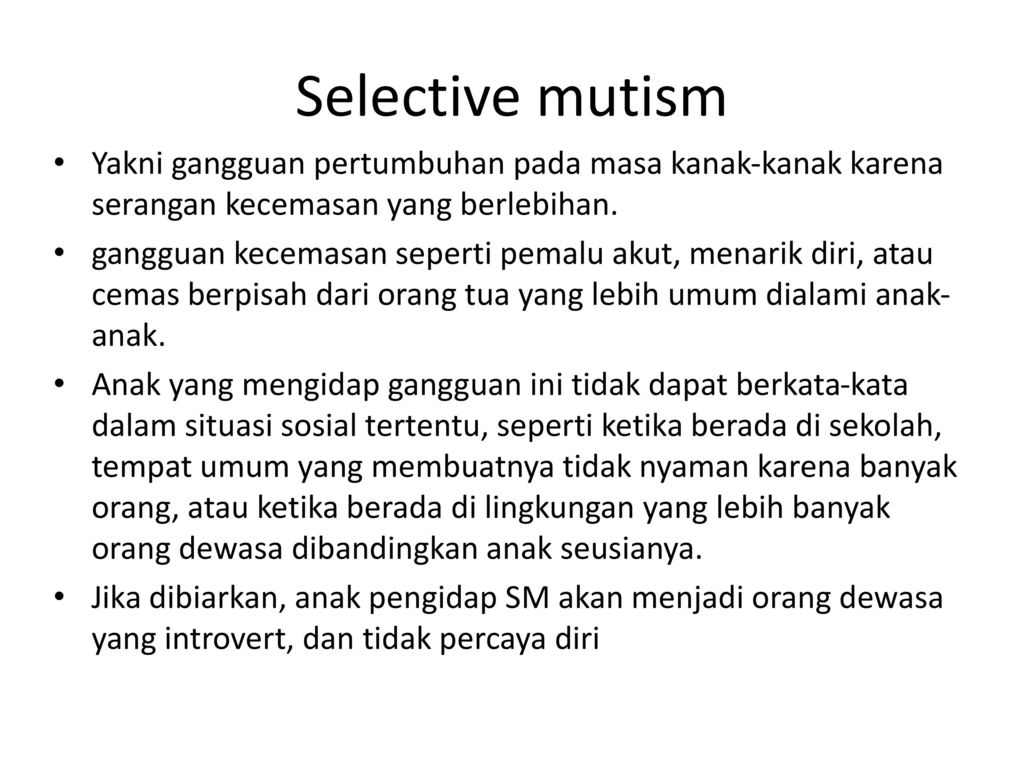 And there is still a myth about what not to say is the choice of the child himself. Another myth is that the problem of SM is necessarily genetic or arises due to a bad psychological situation in the family. But this is far from always the case.
And there is still a myth about what not to say is the choice of the child himself. Another myth is that the problem of SM is necessarily genetic or arises due to a bad psychological situation in the family. But this is far from always the case.
SM is more common in children prone to anxiety. For example, a child is afraid to move away from his mother and play on the playground. Then his mother takes him to a kindergarten and leaves him alone with a large number of unfamiliar children and adults who want something from him and ask questions. And he is so frightened that the vocal cords spasm - the child simply physically cannot speak. But this problem can be solved if a good specialist starts working with the child.
For example, in addition to online consultations, I provide direct therapy and intensive therapy. In the first case, I spend two days with the family: I communicate with the child and with the parents, I watch how the child behaves at home. Then I go to the store with him and try to involve him in the shopping process: we choose what to buy, discuss this or that product, start talking with consultants, the cashier. Everything should happen as naturally as possible and imperceptibly for the child. This technique is called exposure - that is, I create a social situation outside the home and open up the opportunity for the child to communicate with the outside world. During intensive care, I spend a whole week with the child.
Everything should happen as naturally as possible and imperceptibly for the child. This technique is called exposure - that is, I create a social situation outside the home and open up the opportunity for the child to communicate with the outside world. During intensive care, I spend a whole week with the child.
I go with him to kindergarten or school, sit in class and use the sliding in technique - I play with the child, and the teacher goes about his business and is present as if in the background. After some time, I turn to the teacher, involving him in our lesson with the child.
Since I have already established contact with the child by this time, it turns out that the educator does not intrude into the child's space, but we ourselves ask him to do so. And gradually the child "accepts" the teacher and starts talking to him. Of course, sometimes you have to persuade the leaders of the educational institution to give us such an opportunity. Usually, after an intensive session, I continue to keep in touch with my family - and I want to note that there is always progress in one way or another.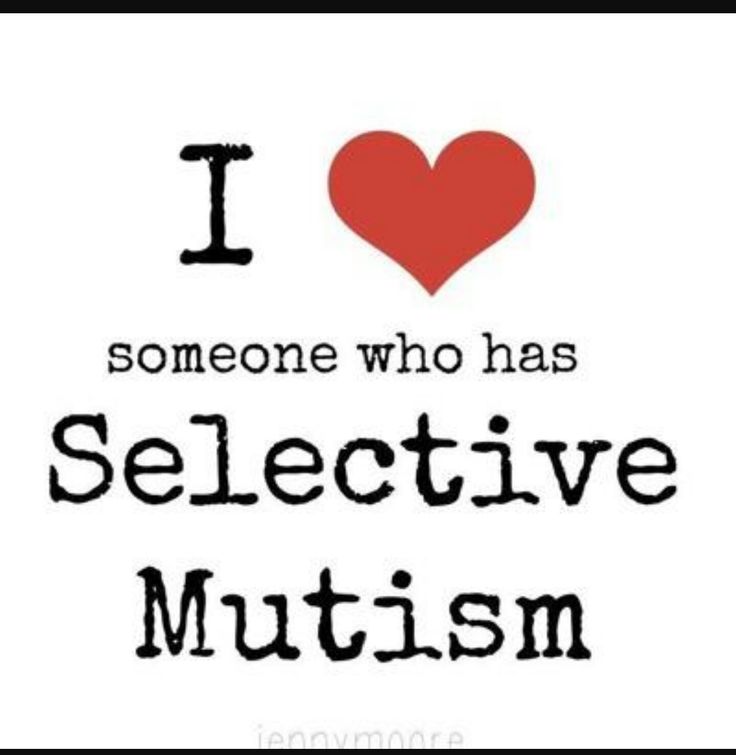 Of course, all children are different and some may need more time. As a rule, this is due to the presence of additional diagnoses in the child.
Of course, all children are different and some may need more time. As a rule, this is due to the presence of additional diagnoses in the child.
I once had therapy with a girl who, in addition to SM, had autism and pathological demand avoidance. She refused many of my proposals and generally resisted communicating with me in every possible way. I had to invent new ways of interaction. For example, I told her: "You are in charge here, so you will choose what we will do today." This is the turn she didn't expect!
On average, a week-long therapy session is enough for a child to start talking at least a little. By the way, drug therapy is not used in the treatment of selective mutism in the UK. The problem is solved exclusively by behavioral therapy. It is also very important to correctly tell your environment that your child has selective mutism. I have written several books about this problem, they are small in size and written in an accessible language - so that the grandmother of the child, and the kindergarten teacher, and even the child from the group could understand what selective mutism is and how to communicate with such a child.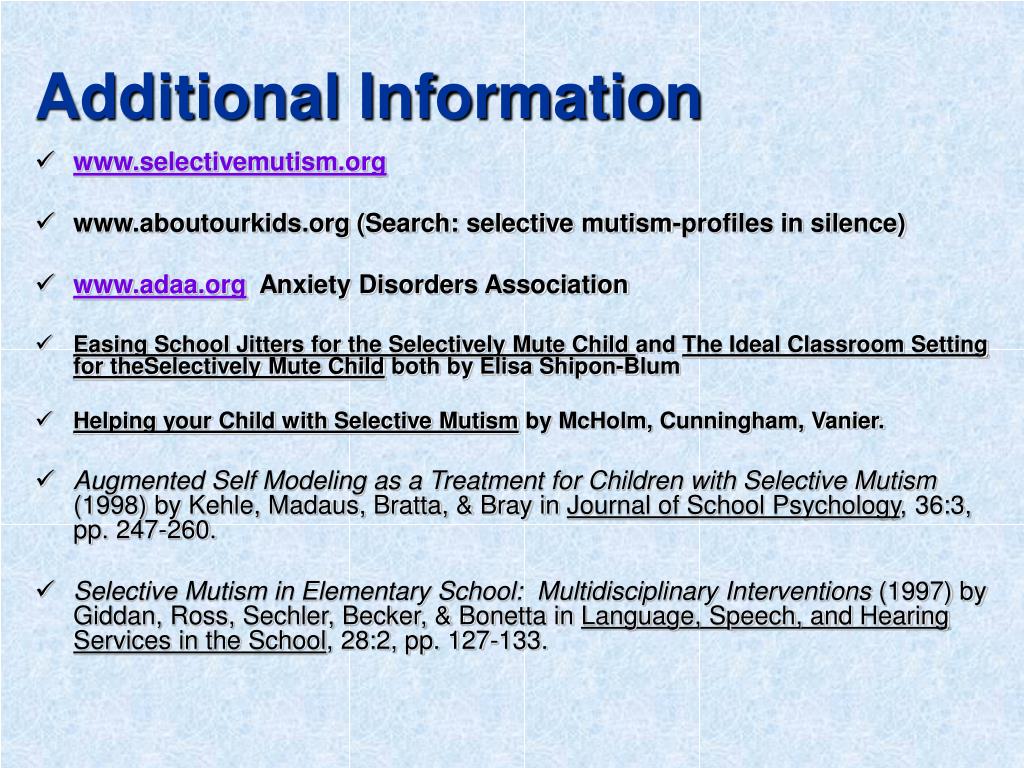
Useful links:
- VKontakte community dedicated to selective mutism;
- UK SM website recommended by Lucy Nathanson;
- Lucy Nathanson's YouTube channel about SM.
Selective mutism: don't be afraid, you need to know how to help the child
All young parents are impatiently waiting for their child to start talking. And now the kid says the first word, then a sentence, then he chats incessantly. But he does this only at home, and is silent in kindergarten and on the playground. What to do? Our blogger, psychologist Lyubov Moshinskaya-Brumberg tells.
Your child speaks well. He chats with you incessantly, recites poetry, sings songs, tells you different things - about the creation of the world, about the Egyptian pyramids, about penguins and crocodiles. But here's the trouble - he doesn't talk in the garden: neither with the teacher, nor with the children.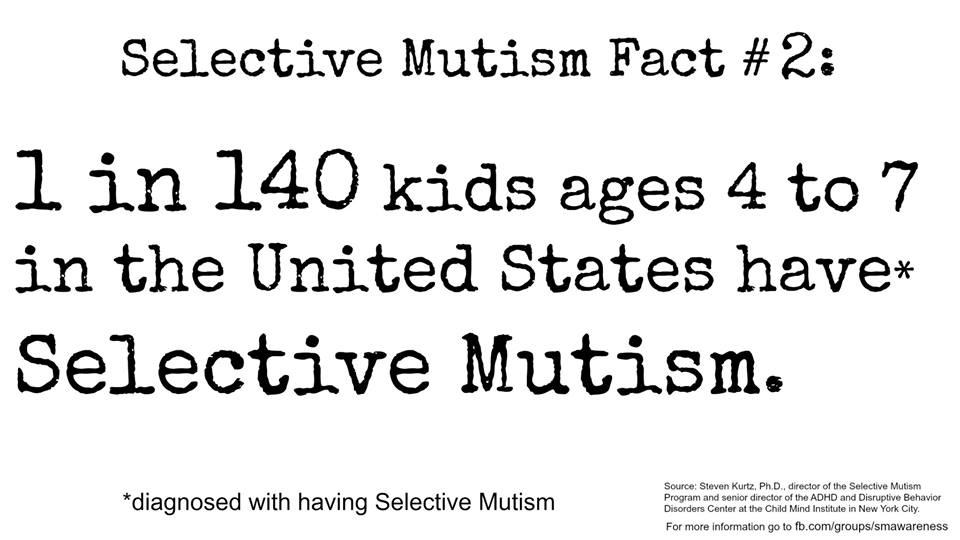 Not in Russian, not in Hebrew, not in Japanese. He does not talk to the children on the playground and to their grandmothers, who certainly want to know his name. He falls silent when friends come to you. And often you are hinted (or directly told) that he has a speech delay. But you know what he says - and better than many.
Not in Russian, not in Hebrew, not in Japanese. He does not talk to the children on the playground and to their grandmothers, who certainly want to know his name. He falls silent when friends come to you. And often you are hinted (or directly told) that he has a speech delay. But you know what he says - and better than many.
This disorder has a name - selective mutism. In translation, it means selective dumbness. In other words, the child's speech is developed normally, but he does not speak with everyone. Anxiety is at the root of this disorder. As a rule, one cannot do without a specialist. But in order to successfully fight this phenomenon, it is necessary to work not only in therapy, but also to cooperate with family and school.
You parents can do a lot to make the child calm and anxiety disappear:
1. Do not worry
First of all, be calm about the fact that not everywhere the child can speak. Your calmness is transferred to the child. And vice versa: when you worry, the child feels your anxiety, and closes even more.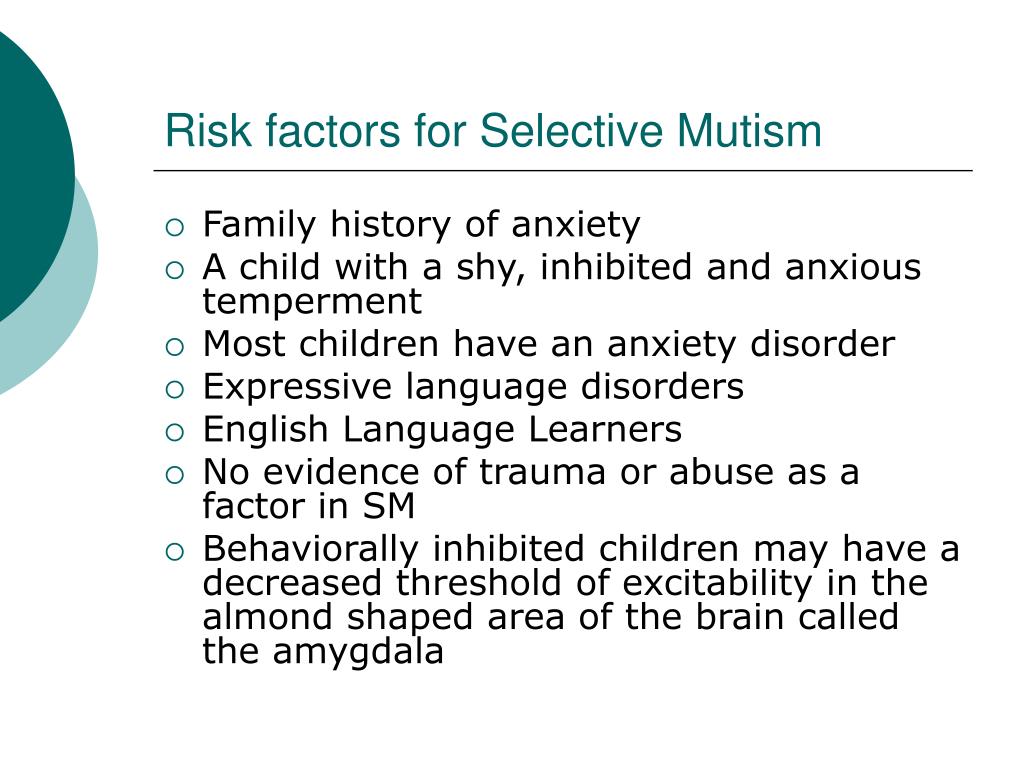 You should not be worried about what the mother will say at the playground, to which your child did not answer what his name is.
You should not be worried about what the mother will say at the playground, to which your child did not answer what his name is.
2. Encourage the child's efforts
Tell the child that it is normal for him to sometimes find it difficult to speak. Just as normal as a child who is afraid of the dark or bad at cycling. Gradually he will overcome these difficulties. And even for small attempts to overcome, he deserves praise. At the same time, it is important to praise not the result (he fell off the bike), but the efforts put into the matter (“you try to learn, despite the difficulties!”).
3. Educate others
Remember that people often do not know what selective mutism is. For example, a kindergarten teacher, teachers at school, relatives who visited you, or the same mothers on the playground try to force the child to speak or make comments to him. This makes it even more difficult for the child. Explain to them what is happening and how to behave with the child.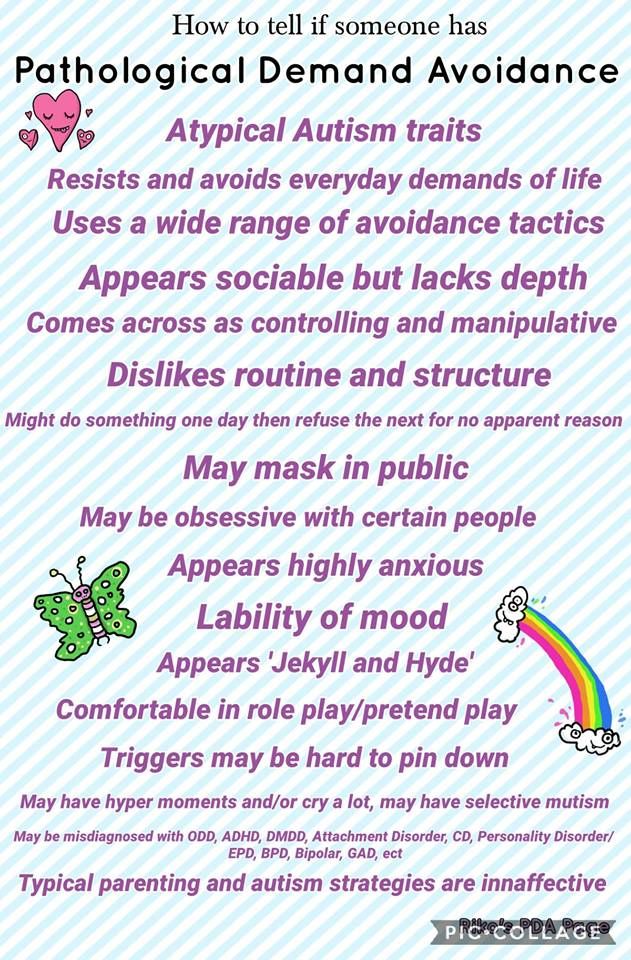 It is very useful to have a conversation with the children in the class and with their parents (in the absence of a child) and explain to them what this violation is.
It is very useful to have a conversation with the children in the class and with their parents (in the absence of a child) and explain to them what this violation is.
4. Remember that you have many reasons to be proud of your child
I'm sure you have many reasons to be proud of your child. Maybe he draws well, manages quickly with Lego, sings, runs, somersaults. After all, verbal communication is just a small part of his abilities. It is worth sharing with others what the child can do well. You can even (with the permission of the child) show them the products of his work (drawings, or origami, or plasticine figures). Then the child will feel that you are proud of him, that he is capable and that there are many reasons to praise him.
Of course, parents can help their child in many ways. Now we talked about support, about keeping the child "afloat", not letting him go deeper into anxiety. How can you help him overcome his anxiety? How can you help him move forward? How can I help him make friends? How to establish his connection with friends and relatives? I will talk about this in the next text.







